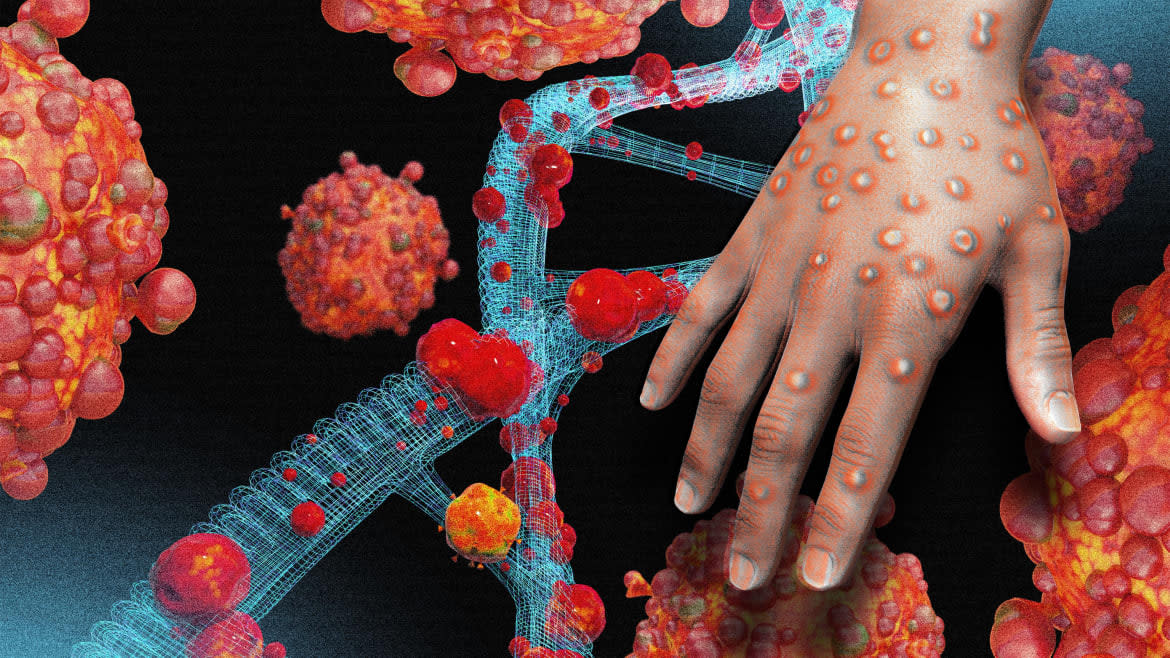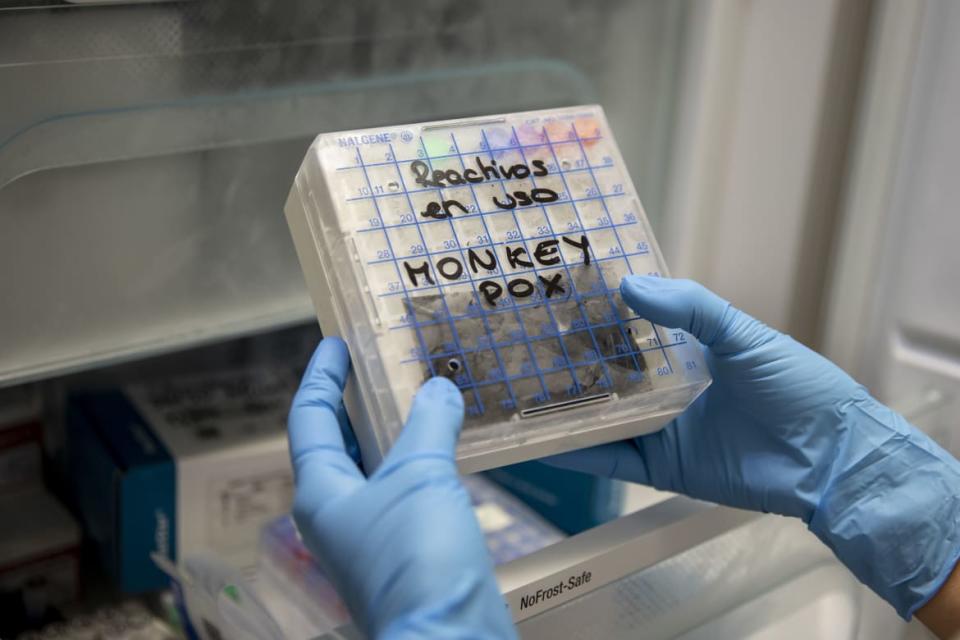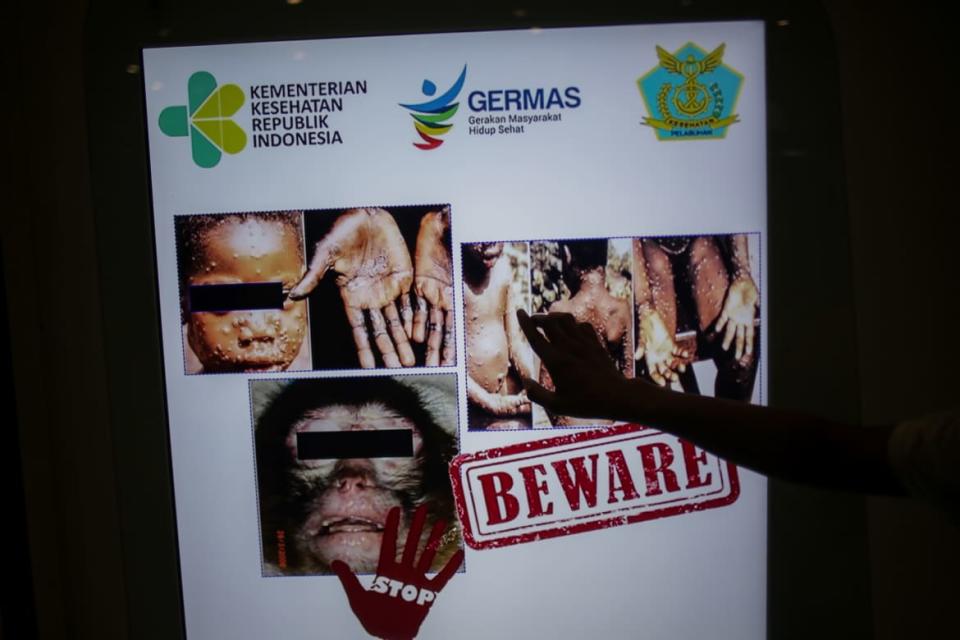The Monkeypox Virus May Be Exhibiting ‘Accelerated Evolution’

The monkeypox outbreak that health authorities first noticed in Europe back in May is getting worse. According to the World Health Organization’s latest report, there are over 2,100 confirmed cases, and at least one person has died.
Now geneticists finally have enough data to begin getting a handle on how exactly the outbreak started—and where it might be heading.
It’s not good news. Monkeypox, a viral disease that causes fever and a rash and can be fatal in a small percentage of cases, is endemic in Africa. And now it’s running amuck on every other permanently inhabited continent—and evolving quickly. While health officials have all the tools they need to contain it—primarily contact-tracing and vaccines—right now the virus is moving faster than we are, and adapting.
The current strain of monkeypox may have been circulating, undetected, months before we finally diagnosed the first case outside Africa. And because there are so many more copies of the virus than we first expected, each mutating separately, this new pox strain could evolve into dangerous new forms with disturbing speed.
“Our data reveals additional clues of ongoing viral evolution and potential human adaptation,” a team led by Joana Isidro, a geneticist with the National Institute of Health Dr. Ricardo Jorge in Spain, wrote in the new peer-reviewed study published Friday in Nature Medicine.

A medical laboratory technician prepares to test suspected monkeypox samples at the microbiology laboratory of La Paz Hospital.
Monkeypox first made the leap from monkeys or rodents to people in the Democratic Republic of Congo in 1970—and has frequently flared up in Africa in the decades since then. There are two main strains, one each in West and Central Africa. The milder West African strain can be fatal in up to 1 percent of cases. The more dangerous Central African strain can kill up to 10 percent of the people it infects.
The pox mostly spreads through close physical contact, especially sexual contact. It’s not a sexually transmitted disease, however. It just takes advantage of the skin-to-skin contact that accompanies sex. The virus can also travel short distances on spittle, although probably not far enough to qualify as “airborne.”
Monkeypox occasionally spreads to places where it’s not already endemic. In 2003, 47 people in the U.S. got sick with the West African strain after exposure to a shipment of pet rodents from Ghana to Texas. A rapid response by state and federal health officials—and a few doses of smallpox vaccine, which also works on monkeypox—prevented anyone dying and temporarily eliminated the virus in the U.S.
Officials first noticed the current outbreak, also of the West African strain, after diagnosing a U.K. traveler returning from Nigeria in early May. Hitching a ride to Europe, the virus spread quickly through physical contact. David Heymann, who formerly headed the World Health Organization’s emergencies department, said that men attending raves in Spain and Belgium “amplified” the outbreak—apparently through close, sometimes sexual, contact with other men.
After that, the virus accompanied travelers on planes heading for countries far and wide. Doctors diagnosed the first U.S. case on May 27. As of Thursday, the U.S. Centers for Disease Control had tallied around 3,500 cases in 44 countries, including 172 in the U.S.
Just one person has died of the pox in the current outbreak—in Nigeria. But serious illness and death can lag an actual diagnosis by several weeks, so it’s possible many more deaths are coming.
Worse, on June 3 the CDC announced it had found genetic evidence of U.S. pox cases that predated the first cases in Europe from May. Doctors may not have noticed or reported these earlier cases, at first, owing to the similarity between pox symptoms and the symptoms of some common sexually-transmitted diseases such as herpes.
There was some speculation that the earlier U.S. cases were part of a totally separate outbreak that just happened to overlap with the May outbreak. Isidro and her team sequenced 15 samples taken from current pox patients and concluded that, no, there’s just one big outbreak. “All outbreak MPX strains sequenced so far tightly cluster together, suggesting that the ongoing outbreak has a single origin,” they wrote, using the scientific acronym for monkeypox.

A passenger walks in front of monkeypox virus information at Soekarno-Hatta International Airport in Tangerang near Jakarta, Indonesia.
It’s less clear exactly when the current outbreak really began. According to Isidro and company, the virus may have been circulating outside of endemic countries long before officials finally noticed the infections and sounded the alarm. The virus potentially traveled beyond Africa in animals such as pet rodents, and spread from animal to animal before finally jumping to a human host and triggering the current outbreak some time prior to May, the geneticists wrote.
Most likely, however, monkeypox spread the usual person-to-person way—and recently, Isidro’s team concluded. “Current data points for a scenario of more than one introduction from a single origin, with superspreader event(s) (e.g., saunas used for sexual encounters) and travel abroad likely triggering the rapid worldwide dissemination.”
In other words, someone—or several someones—touched an infected person in Africa, then flew home to Europe or the U.S., and spread the virus to other people through direct contact. The “single origin” is the infected human population in Africa. “More than one introduction” means multiple travelers picked up the same pox strain and spread it beyond Africa around the same time.
All that is to say. the May case in the U.K. was the first infection authorities noticed, but chances are it wasn’t the infection that started the outbreak.
One particularly disturbing possibility is that the pox is often or even usually circulating to some degree in non-endemic countries, but we rarely notice unless there’s a big surge in infections that compels doctors to look more closely at symptoms that could easily be mistaken for something else. Say, herpes. “When you start looking for something, you find it,” Michael Wiley, a public health expert at the University of Nebraska Medical Center who was not involved with the new study, told The Daily Beast.
In any event, undetected or overlapping transmission vectors are alarming—and not just because they could mean faster viral spread to more places before authorities finally, hopefully, contain an outbreak. No, the multiple introductions also represent an opportunity for a virus to mutate more, or more quickly, than usual.
When it comes to viral diseases, every infected person is a kind of living laboratory—a place where the virus can interact with the human immune system’s antibodies and T-cells and develop countermeasures. The more separate chains of transmission we hand the pox, the more likely the virus is to mutate along these vectors in some way that benefits it and hurts us. For example, developing resistance to our vaccines and antibodies.
Isidro’s team found 50 single nucleotide polymorphisms, or SNPs, in the monkeypox strain behind the current outbreak. Each SNP is a change in the baseline DNA of a particular organism. Fifty SNPs “is far more (roughly 6-12 fold more) than one would expect,” the geneticists wrote. “Such a divergent branch might represent accelerated evolution.”
The Very Alive Woman Conspiracy Nuts Say Died of Monkeypox
That doesn’t mean the pox itself is learning to evolve faster. It’s possible the current outbreak just achieved a kind of genetic critical mass before we had a chance to intervene. More infected people means more opportunities to evolve, even if the individual rate of mutation is the same.
“If I had to guess, I think that we may see more drift in terms of numbers of mutations just based upon the size of the outbreak,” James Lawler, an infectious disease expert and a colleague of Wiley at the University of Nebraska Medical Center, told The Daily Beast. “Drift” is just a fancy term for “increase,” in this context.
Monkeypox may have been hiding in plain sight long before we finally noticed it two months ago. Maybe this strain of the virus got lucky and more than one traveler helped spread it outside Africa nearly simultaneously. Maybe it’s evolving faster because it’s getting cleverer. More likely, it’s changing at its current fast clip because there are so many more copies of the virus than we first expected, each mutating every chance it gets.
It’s all bad news, regardless—and it should stoke an even greater sense of urgency among health officials as they scramble to diagnose and contain a growing number of cases.
Get the Daily Beast's biggest scoops and scandals delivered right to your inbox. Sign up now.
Stay informed and gain unlimited access to the Daily Beast's unmatched reporting. Subscribe now.


